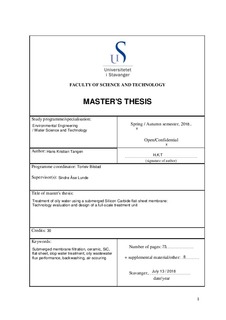| dc.contributor.advisor | Bilstad, Torleiv | |
| dc.contributor.advisor | Lunde, Sindre Åse | |
| dc.contributor.author | Tangen, Hans Kristian | |
| dc.date.accessioned | 2019-01-15T09:56:22Z | |
| dc.date.available | 2019-01-15T09:56:22Z | |
| dc.date.issued | 2018-07-13 | |
| dc.identifier.uri | http://hdl.handle.net/11250/2580629 | |
| dc.description | Master's thesis in Environmental technology | nb_NO |
| dc.description.abstract | Offshore activity in the oil and gas industry generates high quantities of wastewater. It is of interest for the operators to treat this water offshore to limit shipment costs to onshore treatment facilities, in addition to lower environmental concerns. To be able to treat the water offshore, robust technology with high treatment capacity and low footprint is required. Submerged membrane technology using ceramic flat-sheet membranes is a relatively new technology and has not previously been tested on slop water treatment. A collaboration was established with Norwegian Technology AS, which had an interest in testing submerged ceramic membrane technology with air-scouring, on slop water treatment.
Four different slop water types were tested, labelled as S1, S2, S3 and S4. Based on flux performance, S1 was considered as light, S2 was considered as medium and S3 and S4 was considered as heavy slop. Different filtration/backwashing frequencies were tested, and it was found that more frequent backwashing was frequent backwashing was required for more heavier slop than for the light slop.
Permeate fluxes were found to be highly affected by the frequencies of backwashing. Testing S1 water, 1 second of backwash per minute gave 130% higher permeate flux than 10 seconds per 600 seconds.
Net flux of permeate of up to 114 LMH was obtained on the S2 water, with 3 seconds of backwash per minute. Though a net flux of around 30 LMH was mostly obtained over longer filtration periods.
The S3 water was considered heavy, with a net flux of only 3 LMH. Pretreatment significantly increased the flux by 40%, and addition of coagulant increased the flux by 25%.
The membrane was also able to process highly oil-contaminated water. Indication testing performed on the S4 water resulted in an average permeate flux of 49 LMH and a net flux of 17 LMH, with 3 seconds backwashing per minute.
With the produced data from this research, a design of a mobile slop water treatment unit was suggested. The design shows that most of the obtained fluxes was sustainable in this design due to its compactness. The possibility for upscaling the membrane treatment method for slop water was therefore considered feasible, though further studies on long-term durability would be recommended.
The technology was considered promising due to compact and robust structure, suitable on light slop without pre-treatment and on heavy slop in combination with pre-treatment. | nb_NO |
| dc.language.iso | eng | nb_NO |
| dc.publisher | University of Stavanger, Norway | nb_NO |
| dc.relation.ispartofseries | Masteroppgave/UIS-TN-IKBM/2018; | |
| dc.subject | ceramic | nb_NO |
| dc.subject | SiC | nb_NO |
| dc.subject | flat-sheet | nb_NO |
| dc.subject | slop water treatment | nb_NO |
| dc.subject | oily wastewater | nb_NO |
| dc.subject | flux performance | nb_NO |
| dc.subject | backwashing | nb_NO |
| dc.subject | air-scouring | nb_NO |
| dc.subject | offshore teknologi | nb_NO |
| dc.subject | submerged membrane filtration | nb_NO |
| dc.subject | teknisk miljøvern | nb_NO |
| dc.title | Treatment of oily water using a submerged Silicon Carbide flat-sheet membrane: Technology evaluation and design of a full-scale treatment unit | nb_NO |
| dc.type | Master thesis | nb_NO |
| dc.subject.nsi | VDP::Teknologi: 500::Marin teknologi: 580::Offshoreteknologi: 581 | nb_NO |
| dc.subject.nsi | VDP::Teknologi: 500::Miljøteknologi: 610 | nb_NO |
